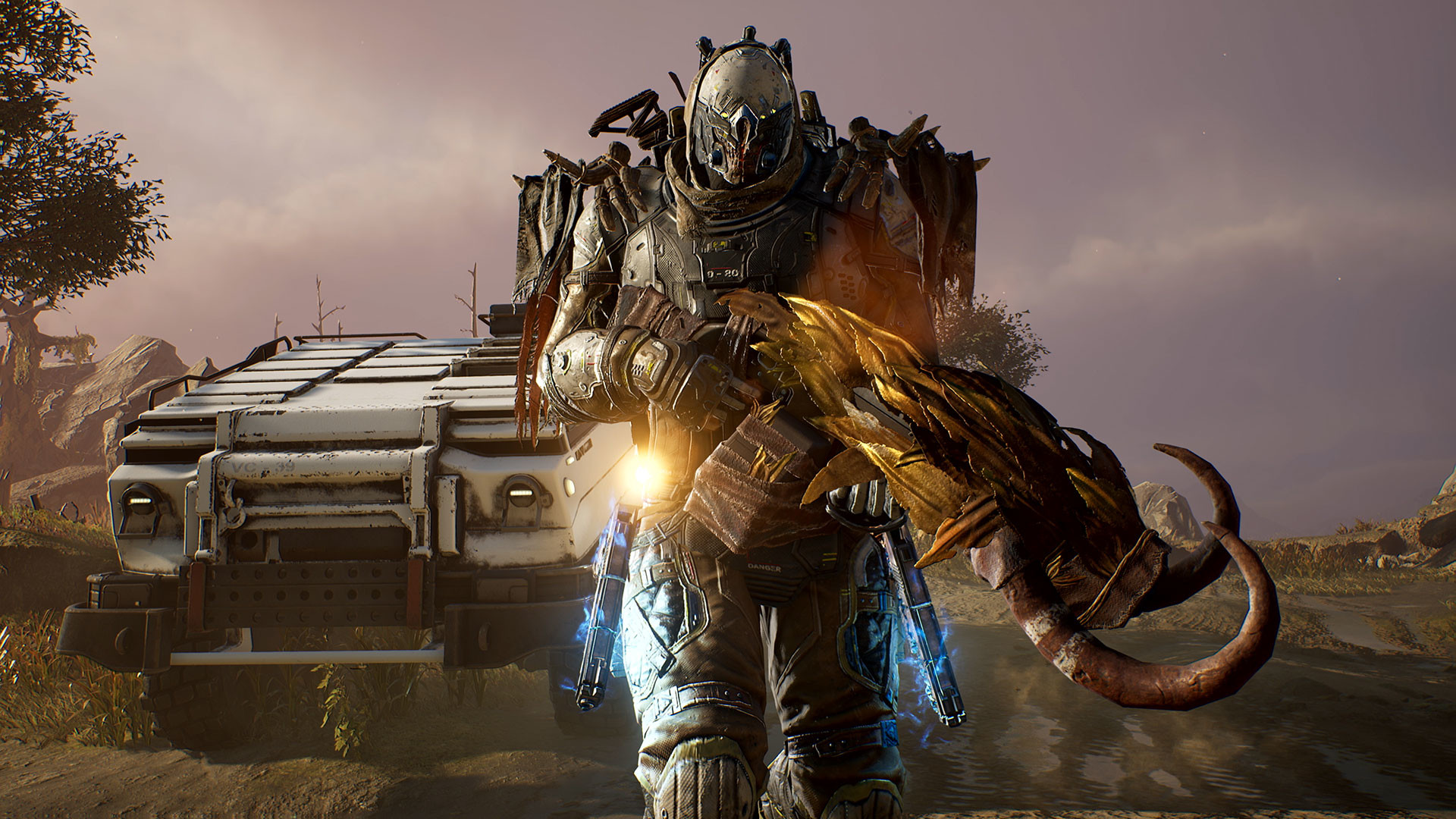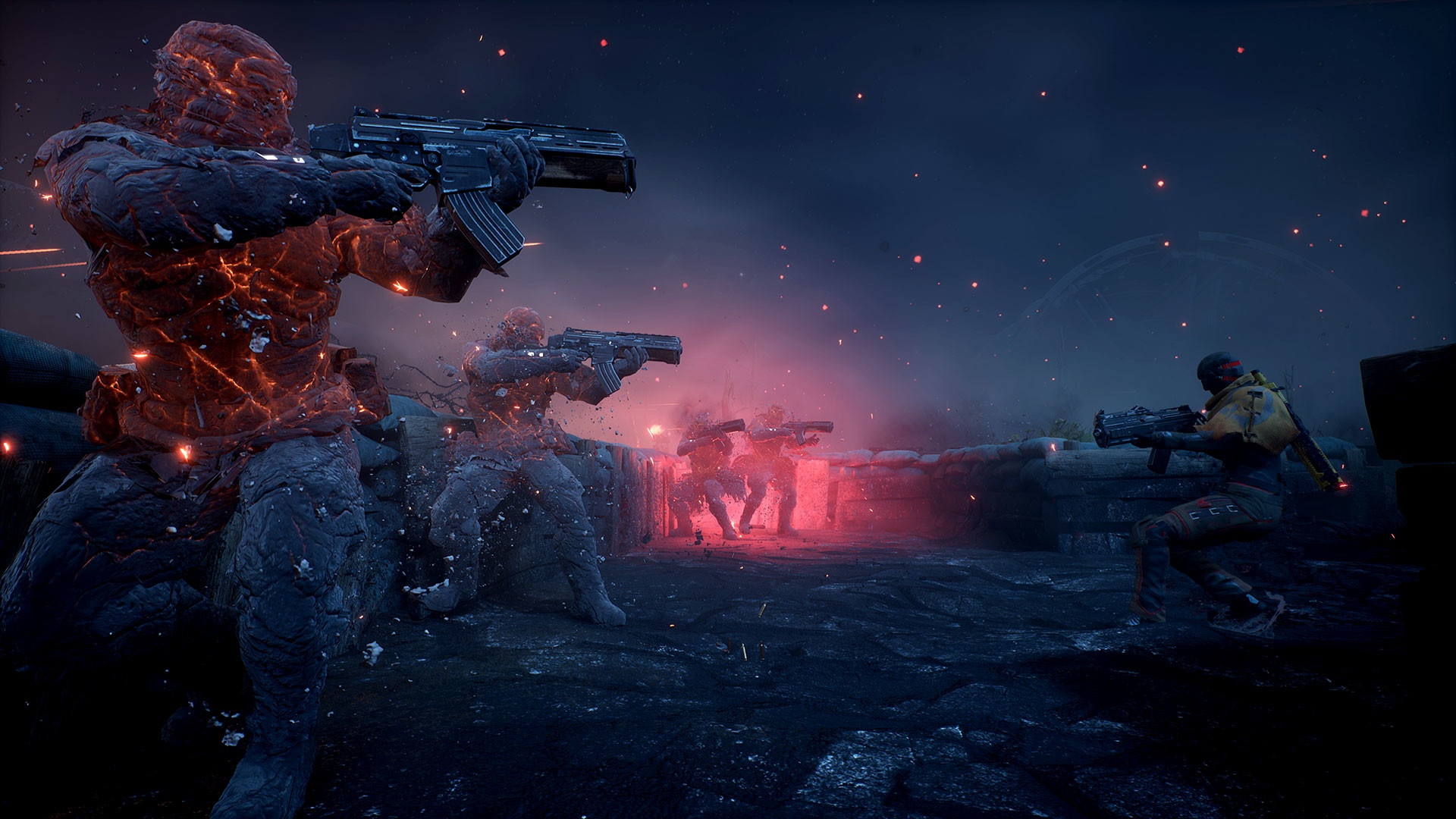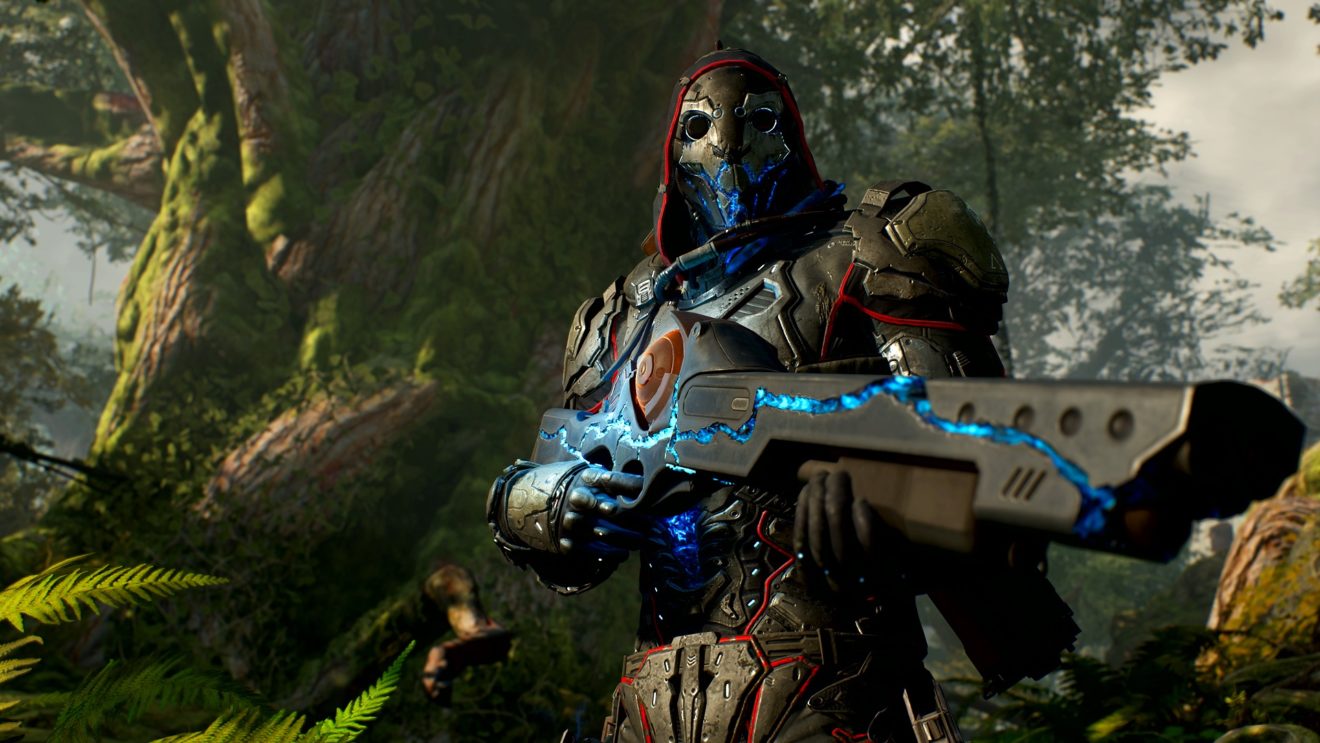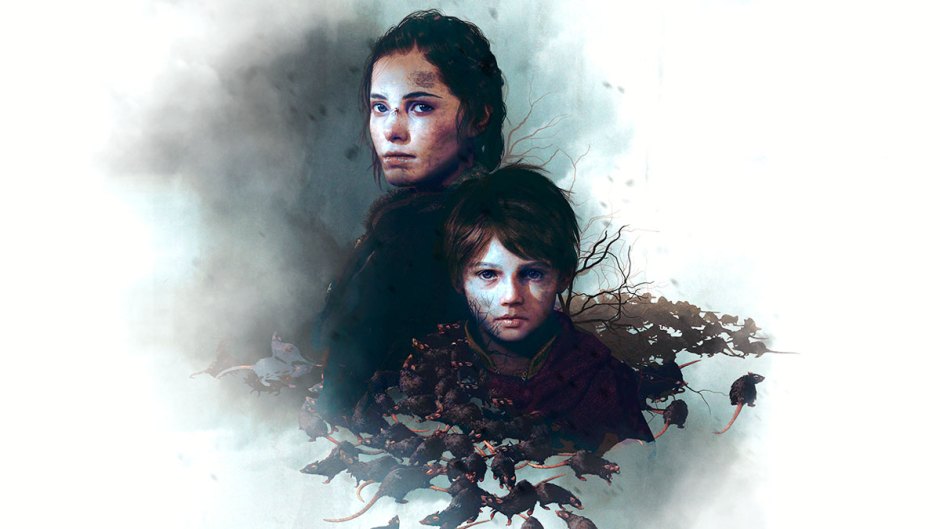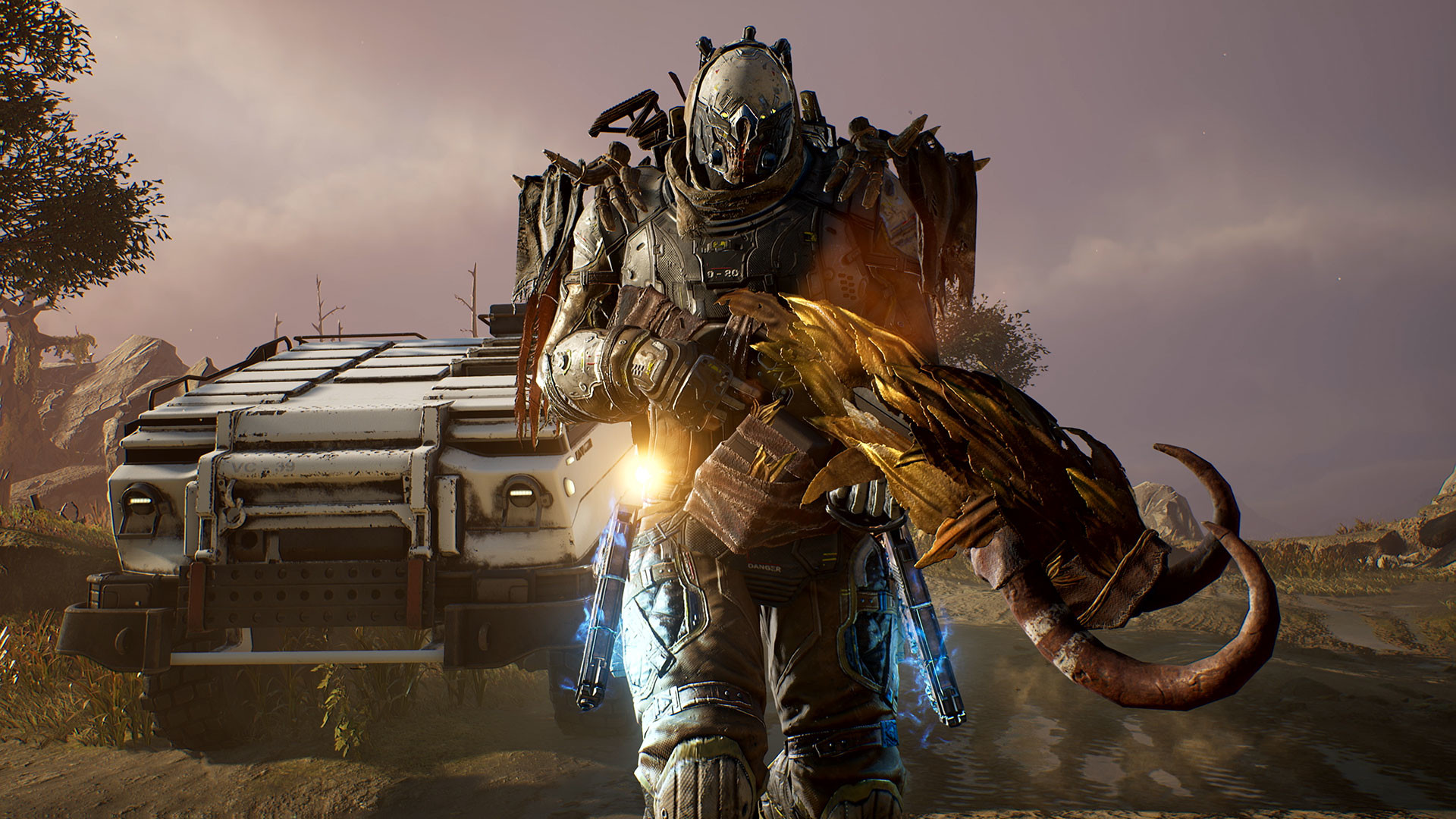
One of the main factors in the explosion of the looter-shooter has been the genre’s inherent ability to get its hooks in you and keep you coming back continuously. For better or worse, Outriders checks most of the boxes to put itself squarely in the same conversation as games like Destiny or The Division, though developer People Can Fly have pushed back against those comparisons. Outriders has a stronger emphasis on single player and focuses heavily on its campaign instead of a long-term endgame, but what truly sets Outriders apart is the very thing that draws the comparisons People Can Fly try to avoid. My enjoyment of Outriders came more from the fundamentally unique gameplay than the disjointed story, and I kept finding myself coming back because of how unabashedly fun it is to be a beast taking down leagues of enemies in seconds and how much the game understands and emphasizes its strengths.
The first hour of Outriders is packed with story setup, and at the end of it, you’re supposed to die. You, along with thousands of other humans, have left an uninhabitable Earth for the planet Enoch, a seemingly peaceful, habitable environment for humans that’s a mere 80 years of cryosleep away. When you arrive, things aren’t as peaceful as they seemed, and a mysterious deadly storm known as the Anomaly takes down much of your fleet, but not before you find a signal broadcasting from somewhere more peaceful on the planet. You’re thrown back into cryosleep and awaken 31 years later to a war-torn Enoch, but soon, in a moment where you’ve been left in the Anomaly to die, you instead absorb power from the storm and become Altered, with superhuman abilities.
"My enjoyment of Outriders came more from the fundamentally unique gameplay than the disjointed story, and I kept finding myself coming back because of how unabashedly fun it is to be a beast taking down leagues of enemies in seconds and how much the game understands and emphasizes its strengths."
From there Outriders’ story really begins. It can be played either fully in single player or in drop-in-drop-out three-player co-op, and there is a heightened emphasis on the campaign when compared to the competition. Its general linearity means that it’s not inherently encouraged to put off the critical path for hours on end to grind, but instead you’re encouraged to keep pushing forward, only really going back to hub cities when absolutely necessary. There’s very little in the way of wide-ranging exploration around each map, as most offshoots of the linear way forward are locked behind contextual side missions. While this may sound restrictive, I appreciate the way the story is told. It still allows you to complete any of the dozens of side missions whenever you want, but it’s also not subtly frowned upon to focus on the critical path and leave side missions for the endgame. Plus, most environments are visually unique and beautiful, especially some with mesmerizing skyboxes and wide-ranging color palettes, and it’s usually enough motivation to move forward just to see the next visual step the game is going to take. It’s worth noting that even in single-player you’re arbitrarily required to connect to the servers, which have had a less than ideal launch and kicked me out multiple times mid-cutscene. It’s still puzzling that a single-player game would do this, but People Can Fly seem to have sturdied the servers significantly since launch.
The story itself, though, is somewhat lackluster. It starts strong and fast, with literal years of lore thrown at you in many consecutive conversations, but once you get rolling on the path to find the signal you heard upon arrival, it doesn’t hold together particularly well. It’s an interesting planet to explore with a lot of backstory, but the plot itself isn’t as engaging as the world it’s set in. The last couple hours try to bring it all together, but so much has happened along the way that it struggles to find a way to conclude properly. Along the way, changes in motivation or objective for the crew often come out of nowhere and with little explanation, and characters are often introduced with little to no fanfare, leaving confusion as to who’s an important character that might play a pivotal role later on and who you might never see again.
Much of the disconnect comes from the story’s overall disjointed feel in its presentation. Cutscenes seem to frequently skip large chunks of time that would seem vital to telling the story. A notable one has the entire crew on a ship that’s about to explode before it hard cuts to the crew standing and watching it explode, forgoing any mention of how they actually escape. This type of jarring scene transition happens somewhat frequently. It’s also not uncommon for in-game dialogue to be cut off by a transition to a cutscene, so you don’t always get to hear everything the game’s trying to tell you, nor is it uncommon to get a story update on a loading screen for an event that happens in an upcoming cutscene. It also doesn’t help that the writing and voice acting are often clunky, making characters feel flat and one-dimensional, and there are jarring moments of flawed sound mixing in cities that left me able to hear the construction in the background over the characters speaking right in front of me. None of these things on their own make the story inherently bad, but taken as a whole, the story feels discontinuous, like its many pieces are never able to mesh into a more cohesive whole. There’s a central narrative here that contains some interesting themes and lovable characters, but I ultimately came away from the story not knowing exactly what it was trying to say.
"There’s a central narrative here that contains some interesting themes and lovable characters, but I ultimately came away from the story not knowing exactly what it was trying to say."
Even with an imperfect story, though, I was consistently compelled to continue playing Outriders because of its looter-shooter gameplay, which is some of the most addictive and satisfying I’ve played in this genre in a while. At surface level, it’s a somewhat standard loot-based third-person shooter. Enemies drop items of different strength and rarity levels and you try to get the best ones to continue improving your weapon damage and armor. You’re pretty much always fighting either the human Insurgents on the other side of the war or the native hostile animals that roam Enoch, though rarely ever together. I like that it’s separated in this way because the two types of enemies call for two wildly different styles of play. When fighting humans, you’ll be behind cover in ways almost reminiscent of Gears of War since you can and will be shot from all directions by dozens of enemies who are using the same types of cover, and if you’re out of cover you’ll be shot dead in seconds. Animals don’t have the same kind of self-preservation and will attack you up close, so they call for a more run-and-gun approach. The level design knows this dichotomy, and there is ample cover when fighting humans and generally more open areas when fighting the animals.
You’re not fighting on even ground, though. Your status as an Altered gives you sets of powerful attacks that depend on your class, each of which has its own skill tree. I played primarily as a Pyromancer, so many of my attacks were fire-based. One sent a wall of flames straight ahead of me, while another drained health in my favor from a targeted enemy, and I generally stuck with the same group of three powers through my entire playthrough. Play as a Devastator and your attacks let you stand your ground or play as a Trickster and you can jump around the battlefield at the drop of a hat. What sticks out about these powers is how well-balanced they are as complements to the gunplay. You can’t survive using either form of attack alone, so there aren’t too many ways to exploit them. To get better and stand a chance against higher-level enemies, you have to use them in tandem with one another, and having both the gunplay and the special powers as visually satisfying as they are makes it so that you want to continue using them together.
Using all of your attacks together makes it almost impossible to not play aggressively, and Outriders overtly encourages aggressive gameplay in every setting. Your health can only regenerate to a certain, relatively low point, and you can only regain the rest back by killing enemies you’ve afflicted with your powers. So, while not every single enemy you kill will give you health, it’s not long until you’re hitting most enemies with some combination of special powers and bullets, and you have to kill enemies to get your health back instead of sitting behind cover. This means that fairly often you have exhilarating moments of going from death’s doorstep with a handful of enemies around you to full health in just a few seconds. There’s a surprising number of varied enemy types, too, even among grunts, so it doesn’t always feel like you’re completing the same fights over and over again. This aspect is the X-factor in Outriders’ addictive gameplay. The vast majority of fights pit you against dozens of enemies, and your ability to never truly be out of a fight gives you constant hope.
"Using all of your attacks together makes it almost impossible to not play aggressively, and Outriders overtly encourages aggressive gameplay in every setting."
The required aggression is a double-edged sword, though. Being able to regain all your health in an instant also comes with the risk of losing everything just as quickly, and if you’re not in range of any enemies to kill, things can turn on you in the blink of an eye, especially with the number of times enemies throw grenades or other explosives with pinpoint accuracy. It also works against you in fights against fewer, stronger enemies. Most encounters contain at least one stronger enemy that often pushes bullet-sponge levels of health. The idea behind them is to focus on them and kill other, weaker enemies to regain the health you lose, but more often than not it was easier for me to kill every other enemy first and focus on the mini-boss last, grinding the pace to a halt. The same goes for bosses, which, while relatively infrequent, forgo many of the strengths of Outriders’ gameplay. They sometimes send weaker enemies at you to encourage the aggressiveness it wants, but they’re generally more frustrating to fight because if they don’t send grunts at you, you’re almost at their mercy. I often found myself running and waiting for my health drain power to recharge, a sequence that actively goes against the fast pace the game wants you to use.
If you do end up finding something too hard, though, you can utilize the World Tiers, which stand in the place of traditional difficulty levels. Higher World Tiers mean stronger enemies and better loot, and you can freely switch between higher and lower tiers, though you can only unlock the higher ones by playing the current highest available one. This isn’t like your character level, where you’ll eventually level up regardless of the enemy difficulty; if you don’t play on the highest available World Tier, you can’t unlock the next one. It’s not too much different from having 15 different named difficulties, but I felt a lot less shame in using the World Tiers fluidly and moving the difficulty down if I was having trouble. Even if I fought later bosses on lower World Tiers, I was ready to go back and fight at higher difficulties to keep improving my character, and the game gives you the freedom to move at your own pace on the difficulty scale.
In terms of the endgame potential, Outriders is clearly not made for the kind of longevity that other games-as-a-service contenders have. The most substantial form of endgame content are the Expeditions, which have you moving through waves of stronger enemies to recover resources from hostile areas, and they introduce a new form of currency not present during the campaign. There aren’t too many of these Expeditions, and they only take up to 20 minutes to complete, so it’s more likely you’ll spend time moving back through older territories trying to unlock higher World Tiers and complete remaining side missions. I’d love to see something reminiscent of Destiny’s raids, but for now this is where the post-campaign gameplay lies.
"Its story is ambitious, if flawed in its execution, but I didn’t really care because the gameplay reaches so much of its potential."
The most rewarding part of Outriders is how much it amplifies its own strengths to organically encourage you to play the way it knows you should. Even if I was frustrated at a difficult fight, I was more excited to get back into the swing of things than I was ready to quit. Its story is ambitious, if flawed in its execution, but I didn’t really care because the gameplay reaches so much of its potential. Outriders is not a flawless game, nor is it one of the tightest or fat-free packages on the market, but its strengths are enough to forgive many of its weaknesses and keep you hooked to save the world again and again.
This game was reviewed on the Xbox Series X.
